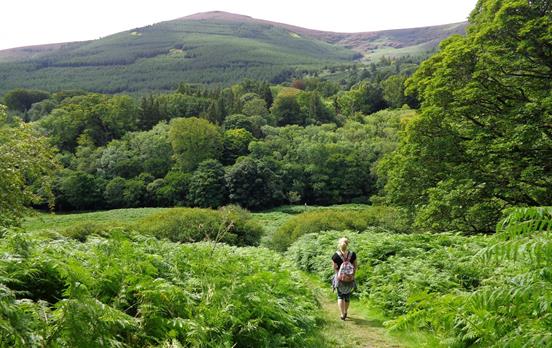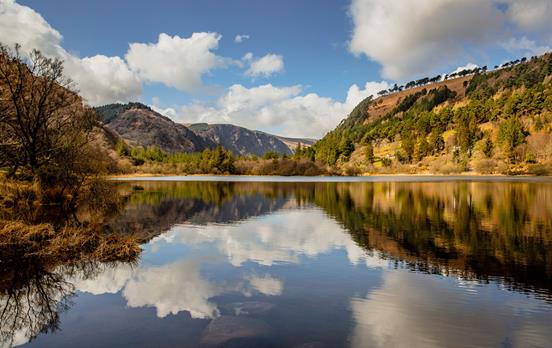Discover The Wicklow Way
-
Points of Interest
Dublin City - Ireland's capital and "UNESCO City of Literature" is easily accessible and worth exploring before striding out into the wild Wicklow Mountains. Make sure to visit Trinity College, the Book of Kells, the Guinness Factory, St Stephan's Green, and the Temple Bar District.
Lough Tay - Also nicknamed "Lake Guinness" because of the dark color of its water which resembles that of a pint of Guinness. It is said that the Guinness family imported white sand to be laid on the northern shore to make it look like the creamy head of the pint. Besides, the lake is on a private estate owned by The Guinness Family Trust.
Glendalough Monastic City - One of the most iconic sites along the Wicklow Way trail dating back to the 6th-century when it was founded in honour of St Kevin. The monastery was a centre of learning and religion and preserved literary works and traditions for over 900 years. Today the valley and its lake are a place of beauty.
Djouce Mountain - Although it is not the highest of the Wicklow Mountains (which is Lugnaquilla at 925m) it is the highest mountain on this route at 725m. Interestingly, the total combined ascent of the full Wicklow Way is 3200m which makes the sense of achievement upon completing the walking trail even bigger!
Powerscourt Estate & Gardens - This majestic estate is rated among the "Top 10 Gardens of the World" and it is not difficult to see why. The country estate is not only known for its well-maintained terraces, shimmering lakes, and 47 acres of beautifully landscaped gardens, but you can also marvel at the breathtaking Powerscourt Waterfall, Ireland's highest waterfall.
![Points of Interest]()
-
Wicklow Wildlife
Here are some of the native animal species that live in Wicklow Mountains National Park, where most of Ireland’s land mammals live.
Deer – Ireland only has one native deer, the Red deer, and these are the largest land mammals. Non-native Sika deer were introduced to the Powerscourt Estate in 1859 before they escaped and started to breed with the Red deer. As a result, there are very few pure Red deer left in Wicklow. The deer along the trail in Glendalough (Spinc & Glenealo Valley) are used to walkers and are often relatively close.
The Irish Hare - This is a truly unique native species as unlike its continental cousins, the Irish hare does not turn white in winter. They live in open habitats and in the mountains. Rabbits can also be spotted, usually on the lower altitudes where it is drier and therefore more suitable for them to dig burrows.
Goats – Large herds of feral goats can be found around Glendalough and there is a bit of confusion around their history. They are thought to have either existed since St. Kevin’s time (who lived in the valley in the 6th-century) or the goats became undomesticated when the mines closed.
Foxes, Badgers & Martens - One of the most common omnivores living in Ireland are foxes (urban or rural red foxes). As they hunt at night or at dusk, they are not often spotted. Badgers are very common too, also more difficult to see as they feed on worms and beetles at night. The pine marten, or known in Irish as 'cat crainn' which translates to 'tree cat', also live in the National Park.
Red Squirrels - Unlike the North American Grey squirrel, the Red is shy and mostly avoids people. The woods and pine trees around Glendalough are the best place to see them. Other rodents found in the National Park are rats and (wood) mice which are known to be the source of food for the local owls and foxes!
Always remember to enjoy wildlife from a distance and leave them undisturbed.
![Wicklow Wildlife]()
-
Top 4 Reasons to Walk the Wicklow Way
Combine a trip to the metropolitan city of Dublin with the remote uplands and glacial valleys of the Wicklow Mountains. The Wicklow Way walking route is accessible, has varied scenery and terrain, and is well-maintained and waymarked.
Because of the remote nature of the trail and the mountainous areas, the accommodations are mainly small, friendly B&Bs and Guest Houses. This really adds to the experience and you can be sure of a warm Irish welcome, hearty meal, and comfortable bed!
Visit some of the most interesting sites, such as the ruins of Glendalough Monastic City, the historic downtown of Dublin, the Powerscourt Estate, the sheer beauty of Glenmalure Glacial Valley and the far-reaching views across Lough Tay and Djouce Mountain.
We take away the stress and hassle of organising the logistics of walking this trail yourself. With our expert knowledge of the area and connections with local providers, all you do is choose an itinerary, we will take care of anything else! From booking our hand-picked B&B’s to organising daily luggage transfers, and 24/7 emergency support.
![Top 4 Reasons to Walk the Wicklow Way]()

































































 Canada
Canada